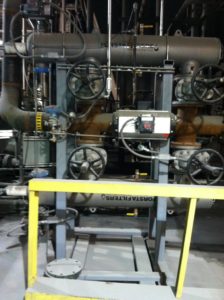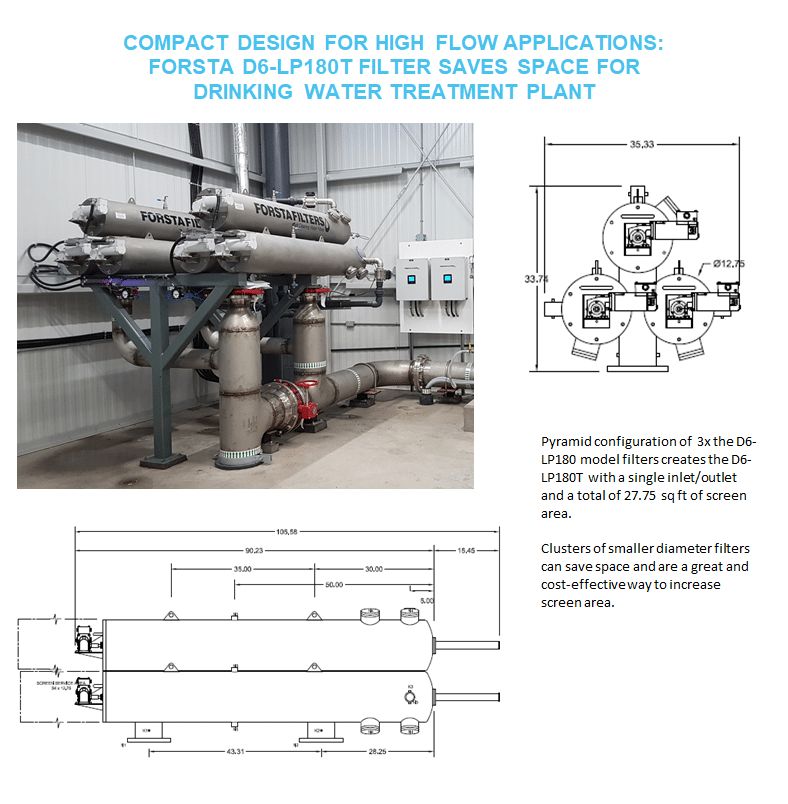Many facilities work with space constraints when planning for new or replacement equipment. Forsta’s dual and triple configuration single-unit filters are a great way to address space limitation.
Self-Cleaning Filters in Latin America

In selecting a filter to improve the system’s performance, Presley had to consider the variability of the incoming river water quality, and the price and maintenance required from a new piece of equipment. After reviewing the available technologies and their costs, RG Steel decided on a Forsta Self-Cleaning Screen Filter for the job.
Based on the technical data, Forsta engineers recommended the D8-180 Series model for this application. The fully automatic filter made from stainless steel 304L, was sized with 8″ flanges for the inlet and outlet, designed to operate at pressures from 40-150psi and at a maximum temperature of 210 F. A high porosity stainless steel 316L screen was selected for the filter with 50 micron openings and 9.25sgq ft. of screen area. Two identical D8-180 filters installed in parallel were slated to accommodate the 1200gpm flow at two locations in the mill.
 |
| Forsta Industrial self-cleaning water filters in RG Steel Mill |
Forsta Design Engineer Daniel Stenberg commented that, “The significant variable in sizing the filter and selecting a screen for this application, was the quality of the incoming river water. With their 1200micron prescreen, we knew they could still expect to see variability in the inlet water based on the conditions of the river due to weather etc. I wanted to provide RG Steel with a solution that would stand up to the fluctuations in the water quality and not create an environment where the filter became overwhelmed. At the same time, it was important to provide a fine enough screen to provide adequate protection for the spray nozzles – the main reason for adding our filter. Based on the data, a 50 micron screen was chosen for their application.”
Since the filter’s installation, Presley explained that it operates for a 20 minute heat once every hour. During operation he typically sees the filter go through one cleaning cycle. Depending on river conditions, this may vary slightly, but the filter is easily handling the particle load variation. Presley said that the new equipment has prevented spray nozzles from plugging and also has allowed them to better control their emissions unit. They are satisfied with their purchase and would recommend Forsta Self-Cleaning Filters to others with similar applications.
Water Use Efficiency:
Forsta self-cleaning filters have remarkably lower flush volumes than sand filter models. To analyze the water efficiency of a sand filter versus a Forsta self-cleaning filter, one can easily compare performance parameters using the common application of side stream filtration for cooling tower water. Take a sample side stream cooling tower application of 250 gpm. For this application, the average recommended 54 inch sand filter requires approximately 1000 gallons to backwash. For this same application a Forsta Filters D-180 uses only 50-75 gallons.
Sand filters require 3-4 minutes for their backwash and cause interruption to the system during that time. Alternatively Forsta self-cleaning filters take only 15 seconds to backwash and will not interrupt the main system flow during the cleaning cycle. Sand filter manufacturers may offer multiple units with a multipart system of isolation valves in an attempt to overcome this problem, however this drastically increases the cost and complexity of the system. Simple design is upheld and extraneous spending avoided by implementing a Forsta self-cleaning filter.
Space Utilization:
Frequently the engineering of a water filtration system must take into consideration a limited amount of space. Forsta self-cleaning filters have less volume consuming configurations than sand filters. For volume comparison, take the same 54 inch sand filter mentioned above. This sand filter takes up 85 ft3 of space whereas the Forsta Filters self-cleaning counterpart flowing the same 250gpm uses only 8ft3 of space. The sand filter requires special platforms, piping and often additional pumps which take up more space and limit the placement of the filter. Forsta self-cleaning filters are designed in a variety of configurations to integrate easily into existing pipelines.
During the backwash, sand beds rise up and create potential for sand to go out of the backwash pipe.
As a result of the fact that sand essentially hovers during the backwash, it never returns to its original compressed state. Over time sand canals occur and allow particles to pass through. The internal screen element of a Forsta self-cleaning filter delivers a constant and reliable degree of filtration throughout its operation.
Minor damage to a sand filter’s underdrain can easily cause sand from the filter to enter into process water. Sand in the process water may cause unforeseen damage to equipment, prevention of which is the entire reason for installing the filter to begin with. Where this is of concern, sand filter manufacturers recommend installing a basket screen (which requires manual cleaning) as an insurance mechanism. Again, this is a complicated, expensive and maintenance intensive route whereas use of a Forsta self-cleaning filter is straightforward, cost effective, and entirely automatic.Cost:
Cost examination yields an obvious price advantage of Forsta self-cleaning filters over sand filters for matching flow rates and micron ratings. For example, Forsta self-cleaning models flowing 250 gpm at the 30 micron level cost less than half of the sand filter equivalent.
Forsta Filters Inc. Engineering Department
Forsta Filters Inc. 2011 All rights reserved
 |
| Forsta Industrial Cooling Water Filters |
Michelsen Packaging Co. in Yakima, Wash., had just installed a 125 hp water-cooled air compressor that required cooling water in order to prevent overheating. According to Michelsen’s research and development engineer, Carey Bruskland, the application required the company to cool the heated water coming from the compressor through a set of heat exchangers. The cooling water on the other side of the exchangers contained fine paper fibers and biological growth, which thrived in the heat generated by the vacuum pumps. Both the fibers and the bio-growth had to be removed to ensure that the heat exchanger wouldn’t plug.
“We needed two high-quality durable filter units that would be self-cleaning and easy to maintain,” Bruskland says. “They needed to be made from noncorrosive materials to withstand harsh chemicals and be able to supply the 100 gpm flow to our heat exchangers throughout the cleaning cycle.”
Bruskland and his team selected the Forsta A2-90 filter model equipped with a100 micron, stainless steel screen. The A2-90 would protect the heat exchangers, which cool the water for the water-cooled air compressor. The selection came following an analysis of Forsta’s technology, including system integration, internal components and backwash mechanism.
Michelsen chose Forsta because the company provided, “high quality units at a lower cost than the other manufacturers.” Bruskland says. “We also really liked the fact that the filter operates on inlet-water pressure alone and does not require an external source of water for the very short backwash.
 |
| Automatic Self-cleaning Filters |
“This was our first filter unit of this type, so we had many questions,” Bruskland says. “The Forsta engineers were very helpful and thorough as we were looking at the different types of filter units and choosing the unit which best fit our needs.” He says that Forsta engineers “were always very courteous and professional. We were always able to get in contact with them and they always answered our questions. They were very helpful not only before we purchased the units but also as we were assembling them. They followed up and contacted us after installation to make sure everything was working properly.”
Bruskland says that he would recommend Forsta “very highly” to other companies with similar applications,
For more information on Forsta self-cleaning filters, go to www.forstafilters.com.
